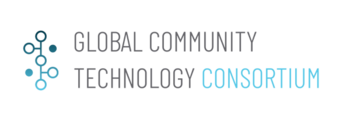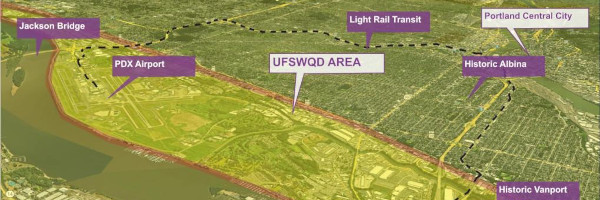Community Engagement and Resilience Program
| Community Engagement and Resilience Program | |
|---|---|

| |
 Urban Flood Safety & Water Quality District | |
| Team Organizations | Green Urban Design Code PDX Urban.Systems |
| Team Leaders | Hugh Harker Charles Kelley Barrett Kenney Wilfred Pinfold Jiri Skopek |
| Participating Municipalities | Portland OR |
| Status | Concept only Stage |
| Initiative | Green Horizons |
| Document | None |
Description
This project aims to address the pressing challenges faced by economically disadvantaged and environmentally vulnerable communities in North Portland. These communities struggle with limited access to jobs, essential services, and face environmental hazards such as air pollution and lack of green spaces. The program seeks to empower local residents and businesses by providing workforce training in sustainable fields like vehicle electrification, energy efficiency, and urban design, while also fostering community-led engagement to improve resilience and promote equitable economic opportunities.
Challenges
The challenges of the project lie in addressing the deep-rooted economic instability, environmental vulnerability, and historical injustices faced by the communities within the Urban Flood Safety & Water Quality District (UFSWQD). These communities, already grappling with limited access to jobs, essential services, and environmental hazards, face significant barriers in engaging with government processes and decision-making, often due to historical mistrust and cultural differences. Additionally, the area’s carbon-intensive industries present a major hurdle in transitioning to a sustainable, low-carbon economy. Overcoming these challenges will require effective community outreach, capacity-building, and collaboration with diverse stakeholders, while ensuring that the benefits of climate resilience and economic opportunities are equitably distributed without exacerbating gentrification or displacement.
Solutions
The proposed solutions include a multi-faceted approach centered on community empowerment, capacity-building, and fostering collaboration. To address the lack of engagement and historical mistrust, the program plans to host community-led workshops focused on cultural competency and historical awareness, ensuring government representatives are trained on the unique histories and needs of the UFSWQD communities. The initiative will also establish dedicated communication channels, including digital platforms for real-time feedback, and formal partnerships with local organizations to ensure ongoing dialogue between community members and government bodies. To tackle economic and environmental challenges, workforce training programs will be implemented in sustainable fields such as vehicle electrification, energy efficiency, and urban design, helping local businesses transition to low-carbon practices. Additionally, the program will offer financial incentives, technical support, and co-created policy recommendations, aligning with both community needs and Oregon’s broader climate goals, ensuring that the benefits of climate resilience and economic opportunities are shared equitably and prevent displacement.
Major Requirements
The requirements include securing strong partnerships with local community organizations, businesses, and government entities to ensure effective collaboration and community engagement. Key requirements involve the establishment of dedicated communication platforms, such as digital tools for feedback and information sharing, as well as the development of culturally inclusive materials and language support to overcome barriers of access. The project also requires the creation and delivery of tailored training programs focused on workforce development in sustainable industries like vehicle electrification, energy efficiency, and urban design. Additionally, formal partnership agreements, including regular advisory meetings and check-ins, are necessary to maintain ongoing dialogue between stakeholders. A dedicated community liaison, along with historical and cultural awareness training for government representatives, will be crucial to ensuring effective engagement and addressing the long-standing environmental and economic challenges faced by UFSWQD communities.
Performance Targets
| Key Performance Indicators (KPIs) | Measurement Methods |
|---|---|
|
|
Standards, Replicability, Scalability, and Sustainability
This project must adhere to several relevant standards, including those related to environmental justice, community engagement, and climate resilience. These include the EPA’s Track II objectives for long-term, equitable community engagement, and the development of climate action plans in disadvantaged areas. The project will follow environmental regulations related to pollution control, such as the Clean Water Act and Clean Air Act, and sustainable urban development standards, including green infrastructure practices. It also supports workforce development standards, ensuring that training programs align with industry needs for skilled labor in the clean energy sector. Furthermore, the initiative could contribute to developing new standards in community-driven, climate-resilient urban planning, as well as in inclusive policies for vulnerable populations in transitioning economies, particularly within the logistics and transportation sectors. Through its partnerships, the project may help shape best practices for integrating environmental and social justice in large-scale infrastructure and business practices.
Cybersecurity and Privacy
Cybersecurity activities relevant to this project include protecting the digital platforms used for community engagement, training, and communication, ensuring secure access to sensitive information, and safeguarding data integrity. This includes implementing robust encryption for online platforms where government updates, meeting schedules, surveys, and policy documents are shared, as well as ensuring secure channels for real-time feedback from community members. Additionally, the project should establish secure access control mechanisms to protect personal data and prevent unauthorized access to sensitive community or business information. Regular vulnerability assessments, user training on cybersecurity best practices, and incident response planning will also be essential to safeguard the digital infrastructure supporting the program. These measures will help ensure that the project maintains the trust of the community and stakeholders while adhering to privacy and security regulations.
Impacts
The impacts of this project are multifaceted, addressing both environmental and social dimensions. By promoting the adoption of clean technologies and reducing carbon emissions in carbon-intensive industries, the project directly contributes to Oregon's climate goals, improving environmental health and resilience in the Urban Flood Safety & Water Quality District (UFSWQD). For the local communities, particularly disadvantaged and historically marginalized populations, the project fosters greater economic stability through workforce development programs, such as training in electrification, energy efficiency, and green infrastructure. This creates opportunities for job growth, enhancing long-term economic mobility and reducing inequalities. Additionally, the project's emphasis on community-led engagement and empowerment helps build trust between residents and government entities, allowing for more inclusive decision-making processes. By addressing historical environmental injustices and increasing access to green spaces, public services, and transportation, the initiative promotes both environmental justice and social equity, ensuring the benefits of economic development and climate resilience are shared by all residents. Furthermore, the initiative's focus on urban design and placemaking could lead to revitalized neighborhoods that are more sustainable, accessible, and prepared for future climate challenges.
Demonstration/Deployment
This project could be best demonstrated through a series of community-led workshops, public events, and pilot programs that showcase its key components, such as clean technology adoption, workforce training, and community engagement. For example, a demonstration of electrified vehicle fleets and renewable energy solutions could be set up to highlight the practical benefits of sustainability efforts within the district. Additionally, showcasing the results of community-led impact assessments and policy recommendations would demonstrate the power of inclusive decision-making in shaping local environmental and economic policies. These demonstrations could be complemented by digital platforms that provide real-time feedback and transparent updates on project progress, illustrating how technology is being leveraged to connect and empower communities. A visual representation of the revitalized, mixed-use neighborhoods—designed with input from the community—could further show the project’s success in improving the local infrastructure, creating a model for equitable urban resilience.